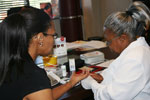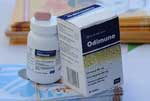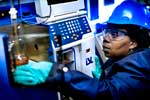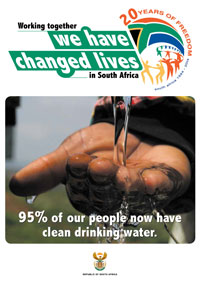We have a good story to tell about the 20 years. South Africa is a much better place to live in now than it was before 1994.
Education
- Grade R enrolment has increased from 300 000 in 2003 to 705 000 in 2011 and is nearly reaching universal access.
- The percentage of 0-4 year olds attending early childhood development (ECD) facilities ha
 s increased by 18,4 between 2007 and 2011.
s increased by 18,4 between 2007 and 2011. - The percentage of 5 year olds attending ECD facilities has increased by 24,6 between 2007 and 2011.
- The adult literacy rate has been increasing steadily over the past 10 years. Illiteracy has decreased from 30.4 % in 1995 to 19.3% in 2011.
- A total of 160 300 students graduated in 2011. This is up from 95 940 in 2001, and up from 144 852 in 2009.
- A total of 45 841 students graduated in the fields of science, engineering and technology in 2011. This is up from 24 907 in 2001.
Health
- More people with TB are being cured. The TB cure rate is increasing consistently, from 54% in 2000 to 73,1% in 2010.
- Fewer children suffer from severe malnutrition. The number of children under five years with severe malnutrition has decreased from 88 971 in 2001 to 23 521 in 2011.
- More children are immunised against diseases. The percentage of infants who has been immunised increased from 63 in 1998 to 90,8 in 2011.
- There has been a steady decline in malaria cases in South Africa. Between 2000 and 2011, cases were reduced by 85% (from 64 622 cases to 9 866 respectively) and mortality by 81% (from 458 to 89 deaths respectively).
- Our public healthcare system works. Patient satisfaction with public healthcare increased from 54% in 2009 to 61,9% in 2011.
- South Africans are living longer with life expectancy having increased from 56,5 years to 60 years between 2009 and 2011.
- HIV and AIDS -

- The anti-retroviral treatment programme for HIV is delivered at more than 3 500 of South Africa’s public health facilities.
- More than 2.4 million children and adults take antiretroviral medication on a daily basis.
- More than 1 million men and boys have been medically circumcised as part of the HIV prevention campaign.
- Mother-to-child transmission of HIV has been reduced to 2.7% at 6 weeks- from 8% in 2008.
- 20 million people tested for HIV over 20 months during the HCT campaign. They now know their HIV status and are empowered to take appropriate steps to maintain their health.
Growth, job creation and income
- The value of South Africa’s gross domestic product (GDP) is over 83% more than it was in 1993 at R3,2 trillion.
- Over R600 billion in Black Economic Empowerment (BEE) transactions have been recorded since 1995.
- The Expanded Public Works Programme created 941 593 work opportunities for the 2012/13 financial year (273 938 Full Time Equivalents), up from 550 000 work opportunities in 2009.
- Our economy has grown by over 80% since 1993. National income per capita has increased by 40% in real terms.
- Total employment has increased by more than 3.5 million.
- Fixed investment increased from 15% of GDP in 1993 to an average of 20% over the past five years.
Rural development
- Since 1994 government has redistributed 7,950 million hectares (or 30%) of the 2014 target to redistribute 24,5 million hectares of the country’s arable land to the previously disadvantaged.
- Since the inception of the restitution programme in 1995, 79 696 claims had been lodged and 77 334 had been settled.
Housing
- South Africa has recorded a 50% growth in formal housing since 1994. An additional 5 677 614 formal homes
 were built over the 20 years.
were built over the 20 years. - The growth in formal housing has led to a shift in the number of people living in formal housing from 64% in 1996 to 77.7% in 2011.
- By the end of the 2011/12 financial year government’s investment in new housing totalled R62 billion.
- Through the national subsidy scheme we have housed around 11 million people since 1994. We have built over 3 million houses in that period.
Access to water
- Access to water infrastructure at Reconstruction and Development Programme (RDP) standards or higher stood at 95% in the 2010/11 period compared to just over 60% in 1994.
- Households with access to free basic water increased by 300 000 households from 11.3 million in 2010/11 to 11.6 million households in 2011/2012.
Sanitation
- Access to sanitation continues to improve, growing from 51% of households in 1994 to 83.4% of households in 2011/12.
Electricity
- The number of households with access to electricity grew from about 52% in 1994 to 76.5% in 2011/2012.
Sources:
- Development Indicators 2012
- Keynote address by Ms Zou Kota-Fredericks, Deputy Minister of Human Settlements: National informal settlement upgrading summit, 2 July 2013
- Medium Term Budget Policy Statement 2013 - Speech by Pravin Gordhan Minister of Finance, 23 October 2013
- Deputy President Kgalema Motlanthe: World Aids Day 2013, 1 December 2013





